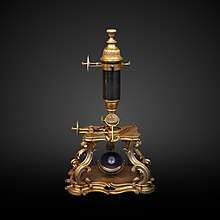Michel Ferdinand d'Albert d'Ailly
Michel Ferdinand d'Albert d'Ailly (31 December 1714 – 23 September 1769), Duke of Picquigny and then Duke of Chaulnes from 1744, was a French astronomer, physicist and freemason.[1]
Biography

The son of Louis Auguste d'Albert d'Ailly (1676–1744), the Duke of Chaulnes, Michel Ferdinand d'Albert d'Ailly commanded the light cavalry of the Maison du Roi (English: King's Household). In 1750 he became the king's commissioner to the Estates of Brittany and persuaded the assembly to accept the Vingtième tax. He married Anne-Josephe Bonnier, one of Marie Leszczynska's ladies-in-waiting and their son Louis Joseph inherited the family dukedom.
As an astronomer and physicist he was particularly interested in scientific instruments and used most of his income to build and collect them. His estate contains a remarkable amount of rare and curious items collected from Egypt, Greece, China, including Etruscan vases of all types, antique bronzes and natural history specimens.
At a time when physicists were abandoning glass globe electrostatic generators, which used sulphur or resin, to use glass plates instead, the Duke of Chaulnes built the largest machine of this type that had yet been seen. He used it to produce the effects of lightning for the first time in France.
In 1743, he was made an honorary member of the Académie des sciences. Two years after, he published a memoir in article form which described his experiments, and was included at the beginning of Newton's Opticks Bk. IV. In this work he described his discovery of the peculiarities of the diffraction of light rays reflected by a concave mirror and how they might be stopped by a board pierced in the middle. In 1765, he introduced an astronomical instrument fitted with two achromatic lenses. He also invented a new microscope and had it built in England; his description of the microscope included several plates. He first thought of the manufacture of artificial mineral water.
He died in Paris in 1769. His eulogy was published in the 1769 volume of the anthology of the Académie des sciences.
Publications
- Nouvelle Méthode pour diviser les instruments de mathématiques, in Description des arts et métiers, published by the Académie des sciences, 1768, in-fol. 44 p. with 15 illustrations.
- Description d'un microscope et de différents micromètres destinés à mesurer des parties circulaires ou droites avec la plus grande précision at Google Books, Paris, 1768, in-fol. 18 p. with 6 illustrations. With this method, the Duke managed to obtain, from a quadrant with a radius of 11 inches, almost the same precision as from a quadrant with a radius of six feet which was at the observatory. He had already published the principles of this work in a thesis of 1755. Some parts of it were also in the Journal de Physique.
- Six works in the anthology of the Académie des sciences.
- His final work was a thesis on a new triquetrum which was stronger and easier to use than previous models.
References
- Chevallier, Pierre (1994). Les ducs sous l'acacia: Ou, Les premiers pas de la Franc-Maçonnerie française, 1725-1743 (in French). Geneva: Slatkine. ISBN 9782051013253.